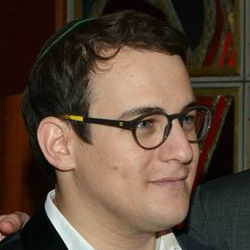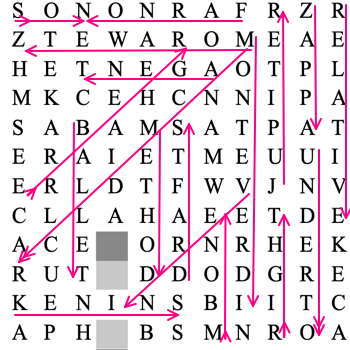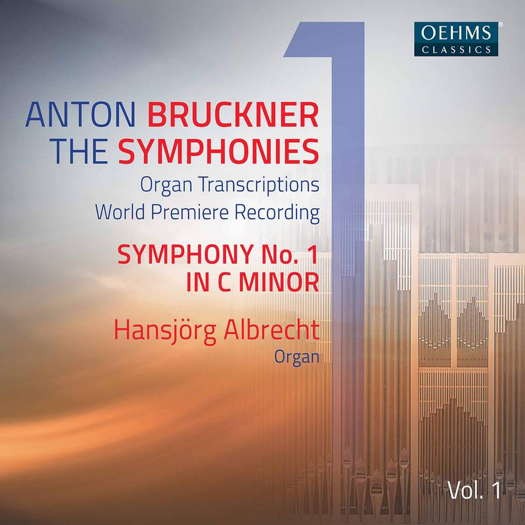ARTICLES BEING VIEWED NOW:
- Régine Crespin
- Hector Berlioz
- Ruth Railton
- Marián Varga
- Profile. A Very Positive Conductor - Paul Bodine talks to Los Angeles Opera's Music Director Designate, Domingo Hindoyan
 SPONSORED: Ensemble. Melting Rhapsody - Malcolm Miller enjoys Jack Liebeck and Danny Driver's 'Hebrew Melody' recital, plus a recital by David Aaron Carpenter.
SPONSORED: Ensemble. Melting Rhapsody - Malcolm Miller enjoys Jack Liebeck and Danny Driver's 'Hebrew Melody' recital, plus a recital by David Aaron Carpenter.
All sponsored features >>
 WORD SEARCH: Can you solve Allan Rae's classical music word search puzzles? We're currently publishing one per month.
WORD SEARCH: Can you solve Allan Rae's classical music word search puzzles? We're currently publishing one per month.

A Monumental Composition
Bruckner's first symphony transcribed for organ, heard by GERALD FENECH
'... towering performances ...'
Anton Bruckner (1824-1896) started composing what is today known as his First Symphony in 1865. But before he came to that point, a decade of studying and experimentation had to take place. In November 1855 the composer passed an exam for the post of organist at the Municipal Parish Church in Linz. Following this success, in January 1856 he was able to acquire the connected position at Linz's Cathedral, which in turn led to his being appointed church organist in April 1856. Bruckner was to hold these positions for a dozen years, and these experiences were invaluable in his efforts to shape the organ at St Ignatius, which together with the latter was in dire need of reconditioning. These endeavours completed, Bruckner could now display his exceptional virtuosity to all and sundry. That is one reason why the organ heard on this recording is the newly revamped Rieger organ of Linz/Brucknerhaus.
Also around this time, Bruckner got involved with a male-voice choir with which he would gain some renown and eventually become their choir master. He also began a correspondence course with Viennese music theorist Simon Sediter, which he completed in 1861. Later that year the composer sought further instructions with Otto Kitzler, the Kapellmeister of the Linz Theatre Orchestra, who introduced him to the music of Wagner, Schumann and Mendelssohn. Bruckner was literally overwhelmed and this experience pushed the composer to decide on embarking on a serious composing career. During the eighteen months he studied with Kitzler, Bruckner kept a journal of compositions which contained the 3 Orchestral Pieces, WAB 97, and the March, WAB 96, both included on this issue.
Listen — Anton Bruckner, transcribed by Erwin Horn: March, WAB 96
(track 4, 0:00-0:59) ℗ 2021 OehmsClassics Musikproduktion GmbH :
Following this intense period of preparation, Bruckner was now ready to immerse himself in a work that was as bold as it was grand. The Symphony No 1 in C minor was the first work in the genre Bruckner thought worthy of performing. Chronologically it comes after the Study Symphony in F minor and before the No 0 in D minor. This Symphony is the only one he did not write in and for Vienna. The work was finished in 1866 in Linz, but by the time of the premiere on 9 May 1868 Bruckner had effected some minor changes. As was wont of the composer he kept revising the piece, and in 1884 a 'revised Linz version' was finished after seven years of compositional struggles. There is also a Vienna version of 1891 but this differs considerably from the earlier ones.
Listen — Anton Bruckner, transcribed by Erwin Horn: Adagio (Symphony No 1)
(track 7, 0:00-0:57) ℗ 2021 OehmsClassics Musikproduktion GmbH :
The Symphony is a monumental composition that has all the characteristics of what was to come later and, although Bruckner was a marvellous organist, he always wrote specifically for the orchestra. These transcriptions by Erwin Horn are indeed revelatory as they distill the essence of Bruckner's language with the utmost clarity, and the unity of the external and internal structures is revealed with amazing dexterity.
Listen — Anton Bruckner, transcribed by Erwin Horn: Scherzo (Symphony No 1)
(track 8, 8:45-9:44) ℗ 2021 OehmsClassics Musikproduktion GmbH :
Hansjörg Albrecht's towering performances, coupled with some sumptuous sound quality and lucid annotations, complete a smashing second volume in this thrilling cycle that promises to be a benchmark in the Bruckner discography.
A must for organ lovers.
Copyright © 13 June 2021
Gerald Fenech,
Gzira, Malta

CD INFO: BRUCKNER SYMPHONY NO 1 IN C MINOR - HANSJÖRG ALBRECHT


